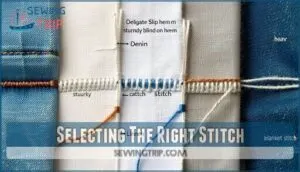This site is supported by our readers. We may earn a commission, at no cost to you, if you purchase through links.

The blind stitch creates an invisible hem that’s perfect for dress pants and formal wear.
For lightweight fabrics like cotton or linen, the slip stitch offers a clean finish without bulk.
Heavy fabrics and stretchy knits need the catch stitch, which allows flexibility while maintaining strength.
Each stitch serves a specific purpose, and choosing the right one makes the difference between a professional-looking hem and a DIY disaster.
The secret lies in matching your stitch to your fabric’s personality and weight requirements.
Table Of Contents
Key Takeaways
- You’ll master three essential stitches – the blind stitch for invisible hems on dress pants, the slip stitch for lightweight fabrics like cotton, and the catch stitch for heavy or stretchy materials like denim and knits.
- Proper preparation prevents disasters – you must remove old hems carefully with a seam ripper, measure while wearing appropriate shoes, and leave 2-2.5 inches of fabric allowance before cutting.
- Match your stitch to your fabric’s needs – lightweight materials require gentle slip stitches, formal wear needs invisible blind stitches, and heavy fabrics demand the flexibility of catch stitches.
- Professional results come from attention to detail – you’ll achieve polished hems by maintaining even stitch spacing, securing knots properly within the hem fold, and finishing with proper ironing techniques.
Preparing The Pants for Hemming
Before you start hemming, you’ll need to properly prepare your pants to guarantee professional results.
The prep work involves removing the old hem, determining your ideal length, and creating clean guidelines for stitching.
Unpick Existing Hem
Anyone can transform their pants with the right unpicking approach. Start with a seam ripper, working slowly to avoid fabric damage. Rushing creates snags that’ll show in your finished hem.
Essential unpicking tips for clean hemming techniques:
Perfect preparation prevents poor performance when removing old hems cleanly.
- Work in good light – See every stitch clearly
- Cut one stitch at a time – Prevents fabric tears
- Remove all thread bits – Leftover pieces interfere with hand sewing
- Check for pulls – Stop if fabric starts catching
- Keep your seam ripper sharp – Dull tools cause more damage
Clean preparation sets up your hand hemming stitches for success. A sharp one will make unpicking seams easier.
Determine New Length
Once you’ve removed the old hem, put on your intended shoes before determining the new length.
Wearing shoes changes how pants fall and affects the final look. Stand naturally while someone pins where you want the hem.
This marking technique guarantees consistent measurement around each leg.
Consider your length considerations – full break, half break, or no break – as this impacts your hand sewing project’s success.
Measure and Pin Hem
Accurate measurement often determines whether your hemming pants project looks professional or homemade. Put on your intended shoes and have someone mark your desired length with pins or chalk.
Follow these essential steps for consistent pinning:
- Mark the hemline – Use marking techniques like chalk or pins while wearing proper shoes
- Pin around the leg – Space pins every few inches for even fabric considerations
- Measure hem allowance – Leave 2-2.5 inches of extra fabric below your marked line
Double-check measurements before cutting. This prevents the dreaded "oops, too short" moment that turns pants into capris.
For marking fabrics, consider using a specialized marking tool for better precision.
Cutting and Ironing for a New Hem
Once you’ve pinned your new hem length, you’ll need to cut the excess fabric and create a crisp fold that’ll make stitching easier.
Leave about 2 to 2.5 inches of fabric below your pin line for a proper hem allowance, then grab your iron to press that fold into place.
Mark and Cut for Hem Allowance
When cutting for hem allowance, accurate marking prevents fabric waste and guarantees professional results. Start by measuring your desired finished length, then add 2-2.5 inches for proper allowance width.
- Mark with precision – Use tailor’s chalk to draw a consistent line around the entire pant leg, guaranteeing accurate marking at every point
- Calculate allowance width – Heavy fabrics need generous allowances while lightweight materials require less bulk for clean finishing
- Apply cutting techniques – Use sharp fabric scissors to trim along your marked line, avoiding jagged edges that compromise your hemming pants project
These pre-cut considerations set the foundation for successful hand hemming stitches and pants hemming techniques. Proper marking requires a quality chalk set for best results.
Iron Hem in Place
With the right ironing temperature and steam usage, you’ll transform your folded hem into a professional-looking crease.
Set your iron according to fabric type—cotton handles high heat beautifully, while delicate synthetics prefer gentler warmth. Use a pressing cloth for wool to prevent shine, and test synthetic corners first to avoid melting disasters.
Fabric Type Heat Setting Moisture Tip
This hem creasing step creates your roadmap for hemming pants with precision. Ensuring a professional hem finish involves cutting excess fabric.
Sharp creases prevent fabric shifting during hand hemming stitches, making your pants hemming techniques foolproof. Master these ironing techniques now, and you’ll thank yourself later when executing those tricky hemming techniques.
Selecting The Right Stitch
Choosing the right stitch makes the difference between a professional-looking hem and one that screams "homemade disaster."
Each fabric type and weight needs its own stitch to create a durable, invisible finish that won’t pucker or unravel.
Blind Stitch for Invisible Hem
Now you’ll create that coveted invisible finish that makes your hemming pants tutorial skills shine. The blind stitch technique catches only one or two fabric threads per stitch, keeping your needle choice sharp and thin.
This invisible hem stitch method works by angling your needle at a shallow slant, maintaining proper thread tension to prevent puckering. For a professional look, consider using the invisible hem stitch.
- Invisibility levels reach perfection when you catch minimal threads
- Fabric types from wool to cotton blend seamlessly with this technique
- Stitch angle creates the magic that hides your handiwork completely
- Thread tension stays relaxed to avoid pulling or distorting the fabric
- Needle choice determines how cleanly your blind hem stitch disappears
Slip Stitch for Lightweight Fabrics
When tackling lightweight fabrics like cotton or linen, you’ll find the slip stitch creates that coveted invisible hem stitch finish.
This hand sewing hem technique catches only one or two threads from your fabric’s surface, making stitches nearly disappear.
Fabric choice matters here—delicate materials need gentle handling.
Use fine needle size and matching thread type while maintaining loose stitch tension for professional results without puckering.
The slipstitch is often used for attaching trims to garments.
Catch Stitch for Heavy or Knit Fabrics
When lightweight fabrics need gentle handling, heavy fabrics and stretchy knits demand the catch stitch hem’s superior strength.
This flexible stitching technique creates a zigzag pattern that moves with your fabric while providing unmatched denim durability.
Here’s why catch stitch works perfectly for hemming pants with challenging materials:
- Stretchy hems won’t pop when you bend or move around
- Heavy fabrics get the support they need without bulk
- Flexible stitching prevents tears in stretchy knits and thick denim
- Hand sewing hem becomes nearly invisible on the right side
- Criss-cross structure distributes stress evenly across the entire hem
Stitching The Hem by Hand
Now you’re ready to put your thread to work and create that perfect hem.
Start by threading your needle with about 18 inches of matching thread and tying a secure knot at the end.
Threading and Knotting The Needle
Cut about 18 inches of thread matching your pants’ color. Thread weight should match your fabric—lighter thread for delicate materials, heavier for sturdy fabrics.
Select your needle size based on fabric thickness. Thread the needle and create a secure knot at the end.
Knot security matters here—you don’t want your hard work unraveling. For a more secure hold, consider twirling thread for knots to create a tighter bind.
Hide the knot inside the hem fold to keep things looking professional.
Executing The Chosen Stitch
With your needle threaded and ready, insert it at a shallow needle angle, catching just one or two fabric threads from the main pants.
Keep your thread tension relaxed to prevent puckering.
Work in your chosen stitch direction, hiding stitches through the hem fold.
Focus on securing stitches properly while maintaining good knot security throughout your hand needle hemming process.
Ensuring Even Stitch Spacing
Perfect stitch spacing transforms messy hemming pants by hand into professional-looking results.
**Consistent spacing turns amateur hand-hemming into polished, professional results.
Here’s how you’ll master consistent tension and stitch length:
- Use marking guides – Place pins every quarter-inch along your hem for accurate needle placement and visual checks
- Practice on fabric scraps – Test your hand stitch types and sewing techniques before working on good pants
- Check your rhythm – Count between stitches to maintain steady spacing and avoid rushing through hand needle hemming
Even spacing creates that polished finish you’re after.
Finishing Touches
You’ve completed your hemming stitches, but don’t celebrate just yet.
The final steps will make the difference between a home-sewn look and a professional finish that’ll fool even your pickiest friend.
Securing The End Knot
Your hem’s success hinges on proper knot reinforcement to prevent unraveling. Create a double looping technique by making two small stitches in the same spot, then pass your needle through the loop twice for backstitch security. This method guarantees your hand stitch a hem stays intact through countless washes and wear.
Next, focus on hiding tails professionally. Run your needle horizontally through the folded hem for about an inch, keeping the thread concealed within the fabric layers. This prevents unsightly loose ends from showing on your finished hemming pants. For a cleaner finish, consider using the single threaded method. This prevents unsightly loose ends from showing on your finished hemming pants.
| Knotting Techniques | Thread Tail Management | Security Methods |
|---|---|---|
| Double loop method | Hide in hem fold | Pull tight gradually |
| Backstitch finish | Weave through layers | Test knot strength |
| Slip knot secure | Run needle horizontally | Check for looseness |
| Lock stitch end | Trim close to fabric | Avoid bulk buildup |
| Reinforced knot | Thread through multiple layers | Maintain even tension |
Test your knot security by gently tugging the hem before moving to the final pressing step. Ensure you have achieved a secure hem that will withstand wear and tear, and that your thread tail is properly managed to prevent loose ends. By following these steps, you can create a professional finish on your hemming projects.
Ironing for a Crisp Finish
After securing your knot, the final step in hemming pants by hand requires proper ironing technique to achieve that professional look.
Here’s your ironing approach for perfect hem preparation:
- Set the right ironing temperature based on your fabric type – cotton tolerates high heat while synthetics need cooler settings
- Apply steam usage carefully – light steam helps set the crease without oversaturating delicate materials
- Use a pressing cloth for protection when working with wool or silk fabrics
This careful ironing creates sharp hem creasing that completes your sewing tutorial perfectly.
Frequently Asked Questions (FAQs)
What is the best stitch for hemming pants?
Blind stitch works best for dress pants since it’s virtually invisible from the front. For heavy denim, you’ll want catch stitch’s flexibility and strength instead.
What is the best hand stitch for HEMS?
Like finding the perfect thread in a tangled sewing basket, you’ll want the blind stitch for most pants hems.
It’s nearly invisible from the front, works on various fabrics, and creates that professional finish you’re after.
How do you stitch a pants Hem?
First, unpick your old hem with a seam ripper and measure your new length while wearing appropriate shoes.
Pin the hem evenly, leaving 2-5 inches of fabric allowance, then use a blind stitch or slip stitch for invisible results.
How do you Hem pants by hand?
Hemming pants transforms loose fabric into a customized fit. Measure desired length, fold hem allowance, pin evenly, then use slip stitch or blind stitch for invisible results.
Should you hand stitch a pant hem?
You should hand stitch pant hems when you want professional results and precise control.
Machine stitching can create visible lines, while hand stitching offers flexibility and an invisible finish that looks polished.
Is there only one way to hemstitch?
Think there’s only one right way to hem your pants?
You’ve got multiple stitch options at your fingertips.
Blind, slip, and catch stitches each serve different fabric needs and visibility preferences for professional results, using multiple stitch options.
What stitch should I use for hemming jeans?
Use a catch stitch for hemming jeans. This flexible, criss-cross pattern handles denim’s weight and thickness perfectly while preventing pulling. It’s strong enough for heavy fabric yet won’t create bulk.
What type of stitch is recommended for hemming of clothes?
Surprisingly, there’s no one-size-fits-all answer. You’ll want blind stitch for invisible hems on dress pants, catch stitch for stretchy fabrics like knits, and slip stitch for delicate materials.
What is the best stitch to hand hem pants?
The blind stitch works best for hand-hemming pants because it creates an invisible finish that looks professional.
You’ll catch just one or two fabric threads, making the stitches nearly undetectable from the right side.
What kind of stitch is best for hemming?
Like a thread weaving fabric together, your stitch choice makes or breaks your hem’s success.
You’ll want the blind stitch for most pants since it’s nearly invisible and works perfectly on dress pants and casual wear alike.
Conclusion
Mastering the stitches to use for hemming pants by hand might seem overwhelming at first, but you’ve just learned the three techniques that’ll save countless trips to the tailor.
Your blind stitch creates invisible hems for formal wear, while slip stitches handle delicate fabrics with ease.
Catch stitches tackle heavy materials and stretchy knits without breaking.
With practice, these hand-stitching methods become second nature, giving you complete control over your wardrobe’s fit and finish.
- https://thefloramodiste.com/blogs/tfm/how-to-sew-5-different-types-of-hand-stitches-part-one
- https://www.reddit.com/r/sewhelp/comments/189x244/what_kind_of_stitch_im_supposed_to_sew_to_secure/
- http://mysewingmall.blogspot.com/2015/11/which-hand-hem-stitch-is-best-for-my.html
- https://summersacres.net/2014/03/how-to-hem-pants-by-hand/
- https://www.sewessential.co.uk/blog/how-to-hand-stitch-hems/













